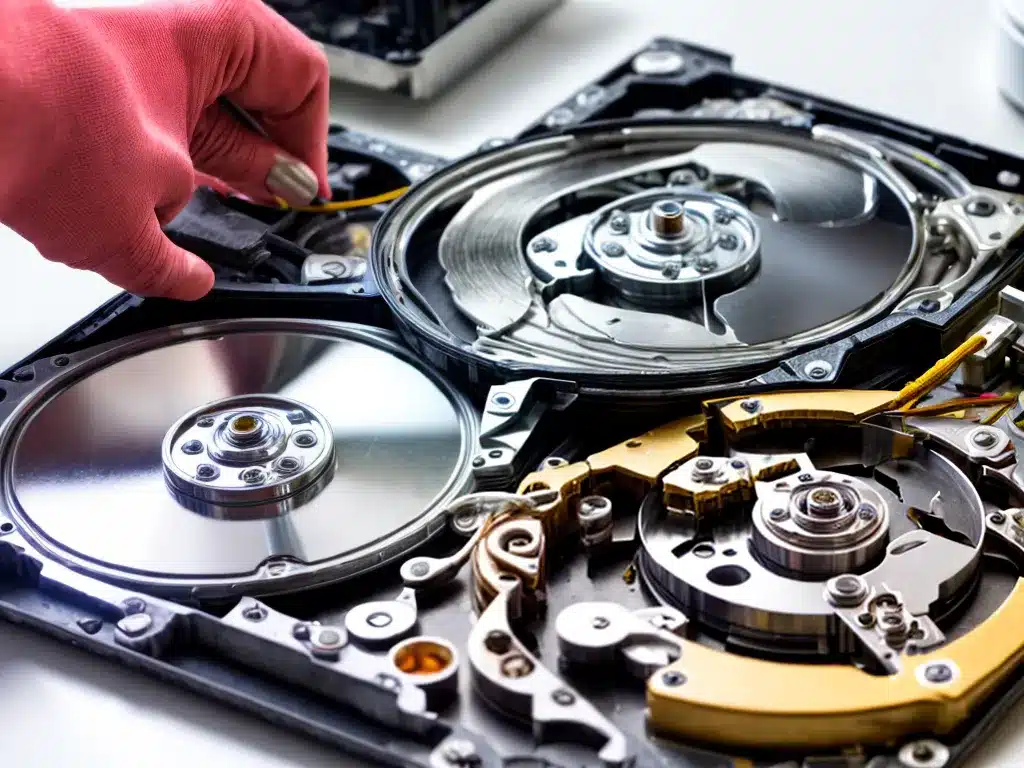
Introduction
Data loss can be devastating. As individuals and businesses become more reliant on digital files and information, ensuring we have multiple backups is crucial. However, sometimes those backups fail or don’t exist at all. When you’ve exhausted all do-it-yourself data recovery options and need to turn to the professionals, data recovery services can often retrieve your files.
When DIY Recovery Isn’t Enough
Do-it-yourself data recovery using software or basic techniques may work for minor data loss. But for major data recovery, specialized services are often the only option.
Common Scenarios Requiring Advanced Data Recovery
-
Hard drive crashes or corruption – Physical problems with a hard drive often require repairs and advanced recovery methods beyond DIY software.
-
Formatted drives – If a drive has been formatted or partitioned, the directories pointing to file data are wiped out. Only advanced methods can rescue data.
-
Deleted files – When files are deleted, the space they occupied is marked as available. Recovery software looks for active files, not deleted ones.
-
Encrypted drives – Encryption scrambles data so it’s unreadable without the passphrase. DIY options don’t have the capability to decrypt drives.
-
Legacy media – Floppy disks, tape backups, and obsolete media can’t be read by computers without the right equipment. Recovery services have the hardware needed.
Limitations of DIY Data Recovery
-
Software can only recover active files – Deleted, corrupted, or encrypted files are invisible to most DIY tools.
-
No hardware solutions – Physical problems like crashed platters require specialized hardware like clean rooms and platter transplants.
-
No advanced skills – Rebuilding corrupted directories and decrypting scrambled data needs expert skills and tools.
When DIY recovery options like software give limited or no results, turning to the experts is the only option.
Choosing a Data Recovery Service
With data recovery being a complex process requiring specialized skills and equipment, choosing the right service is key.
Factors to Consider
-
Success rate – Look for services with a high success rate for your type of data loss.
-
Experience – Choose a service with years of experience and skilled engineers. Look for certifications.
-
Security – Reputable services should provide secure transportation of drives and keep data confidential.
-
Price – Quoted prices may vary depending on the complexity of recovery required. Factor this into your budget.
-
Service types – Some services work on all devices and media, while others specialize in certain types.
-
Reviews – Look at independent customer reviews to gauge satisfaction with service and results.
Do thorough research to choose a service with a proven track record of successful data recovery for your situation.
Data Recovery Process Overview
The data recovery process involves advanced techniques and proprietary methods that trained experts use in a controlled environment. Here are the general phases:
Initial Evaluation
The drive is examined to determine the cause and extent of data loss. Then the service provides a quote for recovery based on the situation.
Data Extraction
Using specialized hardware and software, engineers extract the raw data from the drive to another medium in controlled cleanrooms.
Data Rebuilding
Corrupted directories, databases, or file systems are reconstructed to make data readable and recoverable again.
Data Decryption
For encrypted drives, encryption is decrypted using a variety of methods to access scrambled data.
File Recovery
Once rebuilt into a usable state, files and folders are recovered to another drive so you can access them again.
The process involves proprietary methods only trained data recovery engineers can perform. DIY options don’t measure up.
When to Use Data Recovery Services
Here are common signs it’s time to turn to the pros:
- You’ve exhausted DIY software recovery options without success.
- The drive has physical damage or isn’t powering on normally.
- Files are deleted or corrupted, not just accidentally lost.
- Formatting tools can’t locate files on a drive.
- You don’t have the encryption key or password to decrypt a drive.
Don’t attempt further DIY recovery efforts if they aren’t revealing results. Seek professional services before permanent data loss occurs.
Takeaways
- DIY recovery options have limitations compared to professional data recovery services.
- Choose a reputable service with security, transparency, and a track record of success.
- The recovery process uses proprietary techniques and equipment not available to consumers.
- If your files seem beyond recovery using standard software tools, contact the professionals promptly.
Conclusion
When you’ve exhausted all do-it-yourself methods but absolutely need to recover important data, turning to professional data recovery services offers the best hope. With advanced techniques and capabilities beyond what consumers can access, your files have the greatest chance of rescue by the experts. Just be sure to choose a trusted and reputable provider.












